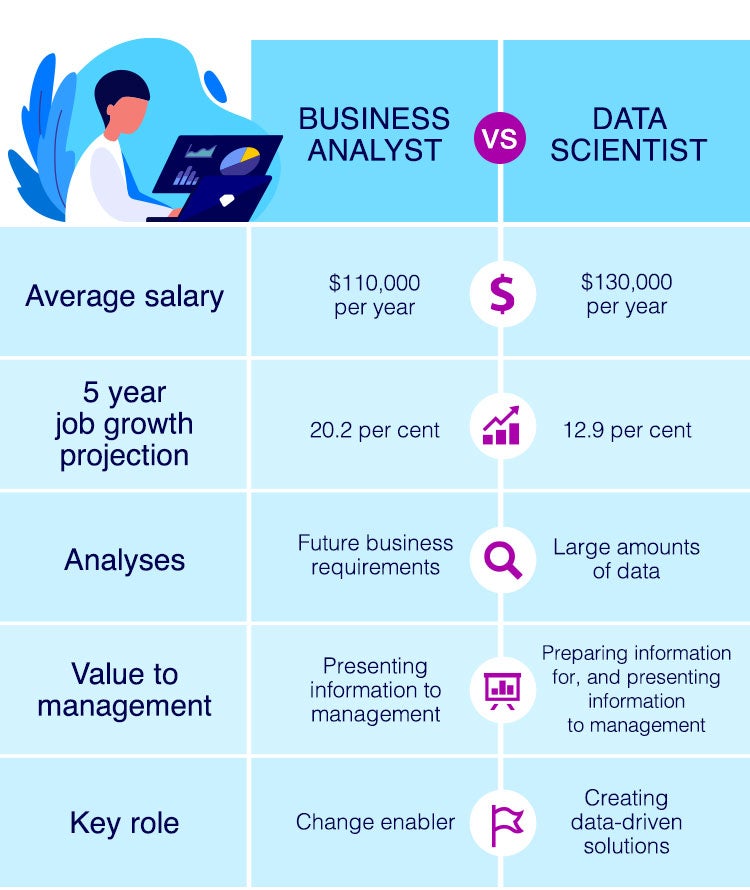Business analytics vs data science: what you need to know before studying

Is the data telling you it’s time to upskill?
Today, analytics is no longer just for analysts. With massive amounts of data being generated at every level of the industry, there’s no doubt that the ability to interpret data is now an essential business skill. It's no wonder that more and more programs are springing up that help business professionals upskill in either data science or in business analytics.
But for a business professional who's never dabbled in data, the prospect of learning data science or business analytics can be overwhelming.
Where do you start? And how can you know what to study to get you where you want to go?
To help you decide, here is our rundown of what you need to know before studying data science or business analytics.
Let's start with defining our terms.
What's the difference between business analytics and data science?
Business analytics was first practised by Adam Smith in 1776 when he broke down the steps involved in the manufacture of a pin. His research showed that with the division of labour a factory could increase the speed of production. Reduced costs and increased profits ensued.
Data science was born in 1962 when John W Tukey published The Future of Data Analysis. The databases and spreadsheets made possible by computers shifted his thinking on statistics. He stopped seeing statistics as a mathematical problem and viewed them anew as a science that could be analysed.
Almost immediately, the information generated by data science was applied in business analytics. As businesses began to analyse data, they identified ways to improve their operations.
Fast forward six decades and here’s how today’s business analyst and data scientist compare.

Salary
According to Seek.com job satisfaction for business analysts and data scientists are both fairly equal. However, while the analyst can expect an average salary of $110,000, the scientist is more likely to average $130,000.
Job growth
Employment opportunities and projections for the five years to May 2024 is where things start to get interesting. Currently there’s about 40 business analyst job vacancies for each data scientist vacancy. It’s a massive gap that’s likely to continue widening.
The Australian Government’s Labour Market Information Portal puts data scientists job growth at 12.9 per cent, while we can expect to see 20.2 per cent more business analyst roles. Unfortunately, neither of those figures take into account any impact caused by COVID-19, so they should be used with caution.
In other research conducted before the pandemic, recruitment agency Robert Walters also forecast growth in demand for business analysts. In fact, in their Salary Survey for 2020, business analyst contractors in Victoria were to expect the second highest wages growth in the country – up 18 per cent to $100 per hour.

Focus of analysis
The International Institute of Business Analysis explains that the business analyst wears many hats, such as defining business cases, collecting information from stakeholders, or validating solutions. They are ‘information conduits’ between business and IT. It’s not unusual to find business analysts taking the output of data scientists and reporting – using it to tell a story that the broader business can understand.
The data scientist is part IT professional, part programmer and part experimental scientist. Microsoft defines the data scientist role as applying machine learning techniques to create models that solve business problems. It’s a role that requires not only an understanding of the problem, but also the ability to build a tool that can provide solutions to the problem.
Key roles and value to management
With their skills in predictive modelling, business analysts are well placed to chart a safe course through technological change. They also have the ability to translate business needs to IT experts and communicate digital updates to a broad range of stakeholders.
For data scientists on the other hand, their key role is to use raw data to produce meaningful insights in their industry. Instead of leading digital transformation, data scientists are more likely to inform the change and then contribute to building the solution. Depending on their role, a data scientist may identify the questions that need answers, build the algorithms that produce relevant information and then present it to management.
Case study: Movember
When the management at men’s health movement Movember wanted to increase annual fundraising levels, they looked to their business analyst. With his business acumen and sophisticated analytical skills, Jeff Guthrie saw an opportunity. He recommended building on the charity organisation’s recent move to Oracle Eloqua marketing automation.
“We have already built in some personalisation via Eloqua with our email communications, so we wanted to do the same thing with our push notifications using the same customer data,” explained Guthrie.
Movember had used push notifications to mobile devices before, but on an ad-hoc basis, rather than integrated into the customer management platform. Guthrie led the change to integrate emails with a push via one of Oracle’s partner ecosystem. These systems easily exchanged data such as the fundraiser’s mobile device, operating system and whether they were using the Movember app.
Fundraisers around the world responded positively to the outcomes with 57,000 opting into push notifications and 90,000 opening promotional push notifications. But the number that really counts is donations – email revenue increased by 48 per cent.
Movember’s Guthrie embodied the key role of the business analyst, which is to be an agent of change. Digital transformation is a priority for many businesses and a reality that’s reluctantly accepted by the rest. Business analysts are increasingly being called on to research, advise and lead organisation wide upgrades.
On the other hand, a data scientist at Movember might analyse the data provided by fundraisers in the Oracle system. From there, they could build and manage customer-centric algorithms that enhance push notifications and emails. Along the way, they would be communicating with Movember management about expectations, progress and outcomes.

Do you have the mindset of a business analyst or a data scientist?
To determine whether you have the mindset of a data scientist, do the maths. In fact, love the maths. Data science thrives on a love for mathematics, statistics and of course, data. You’ll also want to have a healthy relationship with your computer and technology. Together you’ll be pushing the boundaries of machine learning and artificial intelligence to solve the problems that matter.
In the same way that data science informs business analytics, all of the character traits of a data scientist will benefit the business analyst. However, by no means is success in business analytics dependant on all of those traits.
The key to success in business analytics is to be able to think like customer support. The business analyst is a service provider with many colleagues, teams and stakeholders relying on them.
The service provided is information that enables others to make effective business decisions. That requires a good level of business acumen. While business sense is a skill that can be learned, it’s helpful to have a passion for the thrill of business success.
Skills and tools: business analytics course vs data science course
It’s fair to say that business analysts and data scientists have a knowledge overlap in the area of databases and programming or coding languages. The business analyst accompanies this with high levels of business savvy, while the data scientist pairs it with a deep understanding of IT, machine learning and AI. The right university courses for each career will support this asymmetry with skills and tools weighted in the right direction.
Most data science courses are focussed on coding, databases and analytics. Programming classes encourage students to develop proficiency in languages such as Python, R and SQL. Database units will develop skills in gathering, cleaning, enriching and mining data.
The analytics side of data science courses will give you the skills needed for managing and processing big data. You’ll work with high-level maths and statistics tools to build data models that identify trends and solve a variety of problems. Most importantly you’ll learn how to design data visualisations that effectively communicate the story behind the data to your stakeholders.
How to choose?
If you’re leaning more towards data science, you should take a look at RMIT Master of Data Science. With a grounding in the basic skills of data science, this course will enable you to speak the language of data, connect leadership with the data team, and drive business results.
For pure business analytics, RMIT Online’s Graduate Certificate of Business Analytics has been built from the ground up to give you and your organisation a competitive advantage quicker. With a solid base in data science, this is the first qualification of its kind that offers a distinctly business approach to analytics.
You’ll learn how to use tools to develop predictive and prescriptive models for different business scenarios. You’ll gain the skills to visualise and communicate findings and decisions to stakeholders, as well as justify the decisions behind them. There’s less focus on maths, statistics and programming, and more emphasis on communicating data-driven decisions to stakeholders.
With the Graduate Certificate of Business Analytics, you can choose from five electives to suit your career path and develop skills in the workforce, consumer and supply chain analytics. You’ll become proficient in predicting the needs and behaviours of employees and customers. And you’ll gain an understanding of the theories and practices of logistics systems to effectively communicate data-based solutions.
So, what’s the data telling you now? With more than 2.5 quintillion bytes of data being created in the world each year, being able to understand data puts leaders like you in demand.
Learn more about RMIT Online’s Master of Business Analytics and AI Strategy.



